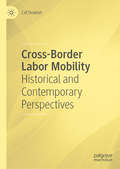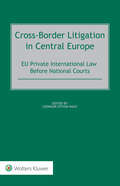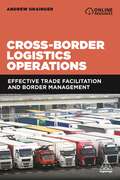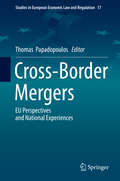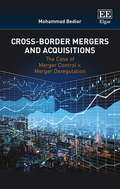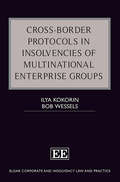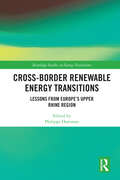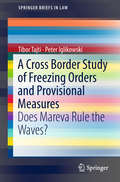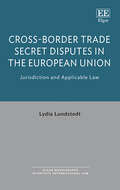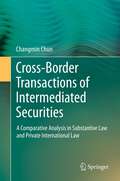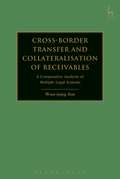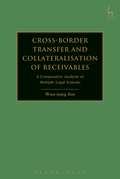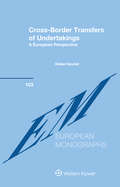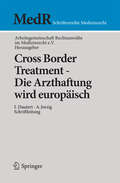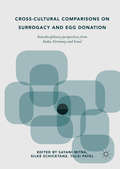- Table View
- List View
Cross-Border Labor Mobility: Historical and Contemporary Perspectives
by Caf DowlahThis book presents a comprehensive review of cross-border labor mobility from the ancient forms of slavery to the present day. The book covers African and Amerindian slaveries, indentured servitude of the Indians and the Chinese, guestworker programs, and contemporary labor migration focusing on the United States, the European Union, and the Gulf Region. The book highlights the economics and politics that condition such trends and patterns by addressing growing anti-immigrant sentiments, as well as restrictive measures in the developed world, and outlines inexorable forces that are likely to propel further expansion of cross-border mobility in the future. This multidisciplinary volume provides a highly dependable scholarly reference to researchers, students, academics as well as policy makers.
Cross-Border Life and Work: Social, Economic, Technological and Jurisdictional Issues (Contributions to Management Science)
by Peter Droege Stefan Güldenberg Marco J. Menichetti Stefan SeidelThis book discusses the risks, challenges, and opportunities of cross-border work and life from a multidisciplinary and multilevel perspective, including (a) the individual, (b) the social and organizational, and (c) the regional levels, taking into consideration the diverse and multilayered social, economic, technological, and jurisdictional issues involved.Emerging public policies and advanced information technologies (IT) have created new opportunities for work and life that thrive in global value chains and markets. Life, in general, and work, in particular, are increasingly organized across borders of various kinds and are subject to rapid change. At the same time, life and work have been determined by 19th and 20th century infrastructures and technologies. As a consequence, new strategies and measures are required for both physical and virtual work and life spaces.
Cross-Border Litigation in Central Europe: EU Private International Law Before National Courts
Cross-Border Litigation in Central Europe EU Private International Law Before National Courts As a consequence of the ever-increasing intercourse within the enlarged and diverse European Union (EU), a growing number of businesses, consumers, and families rely on EU private international law instruments to seek justice in cross-border disputes. This invaluable reference book offers an in-depth understanding of this process in Central Europe and is the first to provide a comprehensive and analytical overview of the judicial practice in the region and to make this case law accessible in English. Presenting the results of a major EU-funded project (CEPIL), the book offers an insight into the reality of EU private international law and cross-border litigation in Central Europe: it provides a comprehensive and exhaustive presentation of the case law in 10 Central European Member States (Croatia, the Czech Republic, Estonia, Hungary, Latvia, Lithuania, Poland, Romania, Slovakia, and Slovenia); it covers all fields of EU private international law (general civil and commercial, insolvency, family and succession matters); it inquires whether EU private international law functions optimally in the Central European Member States in order to secure a Europe of law and justice; it examines whether EU private international law instruments are applied in a correct and uniform manner and whether national courts deal appropriately with disputes having a cross-border element; it analyzes whether the current legal and institutional architecture is susceptible of securing legal certainty and an effective remedy for cross-border litigants. This important practical resource helps businesses, consumers, families and legal counsels engaged in cross-border mobility to gain access to essential information and analysis as to the application and interpretation of EU private international law in Central Europe. The book is also highly valuable to academics and researchers specializing in private international law by presenting the research findings of the CEPIL project.
Cross-Border Litigation in Europe (Studies in Private International Law)
by Paul Beaumont Mihail Danov Katarina Trimmings Burcu YükselThis substantial and original book examines how the EU Private International Law (PIL) framework is functioning and considers its impact on the administration of justice in cross-border cases within the EU. It grew out of a major project (ie EUPILLAR: European Union Private International Law: Legal Application in Reality) financially supported by the EU Civil Justice Programme. The research was led by the Centre for Private International Law at the University of Aberdeen and involved partners from the Universities of Freiburg, Antwerp, Wroclaw, Leeds, Milan and Madrid (Complutense). The contributors address the specific features of cross-border disputes in the EU by undertaking a comprehensive analysis of the Court of Justice of the EU (CJEU) and national case law on the Brussels I, Rome I and II, Brussels IIa and Maintenance Regulations. Part I discusses the development of the EU PIL framework. Part II contains the national reports from 26 EU Member States. Parts III (civil and commercial) and IV (family law) contain the CJEU case law analysis and several cross-cutting chapters. Part V briefly sets the agenda for an institutional reform which is necessary to improve the effectiveness of the EU PIL regime. This comprehensive research project book will be of interest to researchers, students, legal practitioners, judges and policy-makers who work, or are interested, in the field of private international law.
Cross-Border Litigation in Europe (Studies in Private International Law #20)
by Paul Beaumont Mihail Danov Katarina Trimmings Burcu YükselThis substantial and original book examines how the EU Private International Law (PIL) framework is functioning and considers its impact on the administration of justice in cross-border cases within the EU. It grew out of a major project (ie EUPILLAR: European Union Private International Law: Legal Application in Reality) financially supported by the EU Civil Justice Programme. The research was led by the Centre for Private International Law at the University of Aberdeen and involved partners from the Universities of Freiburg, Antwerp, Wroclaw, Leeds, Milan and Madrid (Complutense). The contributors address the specific features of cross-border disputes in the EU by undertaking a comprehensive analysis of the Court of Justice of the EU (CJEU) and national case law on the Brussels I, Rome I and II, Brussels IIa and Maintenance Regulations. Part I discusses the development of the EU PIL framework. Part II contains the national reports from 26 EU Member States. Parts III (civil and commercial) and IV (family law) contain the CJEU case law analysis and several cross-cutting chapters. Part V briefly sets the agenda for an institutional reform which is necessary to improve the effectiveness of the EU PIL regime. This comprehensive research project book will be of interest to researchers, students, legal practitioners, judges and policy-makers who work, or are interested, in the field of private international law.
Cross-Border Logistics Operations: Effective Trade Facilitation and Border Management
by Andrew GraingerWith considerable turmoil in international trade and logistics it is more important than ever to understand trade and customs issues and their impact on logistics operations. At every port and border international freight operations are exposed to trade and customs procedures.Cross-Border Logistics Operations serves as a comprehensive guide and companion to the cross-border trade and customs environment and its implications for international business supply chains and their control. Inspired by the World Customs Organization's Professional Standards (also known as the WCO PICARD Standards), it provides key insights into transporting goods across borders and effectively managing the requirements for compliance and enforcement.International students, business operators and government officials will find the book rich in detail with practical examples that include the political, administrative, regulatory, technological and economic context throughout. It covers all the critical operational and legal aspects of cross-border logistics operations, including:-prevailing trade, customs and border policy-tariffs and import taxes -border management and supply chain security practices-prohibitions and restrictions-enforcement and compliance practices-supply chain and logistics arrangements-disaster relief operations-frictionless trade and trade facilitation principles.
Cross-Border Mergers: EU Perspectives and National Experiences (Studies in European Economic Law and Regulation #17)
by Thomas PapadopoulosThis edited volume focuses on specific, crucially important structural measures that foster corporate change, namely cross-border mergers. Such cross-border transactions play a key role in business reality, economic theory and corporate, financial and capital markets law. Since the adoption of the Cross-border Mergers Directive, these mergers have been regulated by specific legal provisions in EU member states. This book analyzes various aspects of the directive, closely examining this harmonized area of EU company law and critically evaluating cross-border mergers as a method of corporate restructuring in order to gain insights into their fundamental mechanisms. It comprehensively discusses the practicalities of EU harmonization of cross-border mergers, linking it to corporate restructuring in general, while also taking the transposition of the directive into account. Exploring specific angles of the Cross-border Mergers Directive in the light of European and national company law, the book is divided into three sections: the first section focuses on EU and comparative aspects of the Cross-border Mergers Directive, while the second examines the interaction of the directive with other areas of law (capital markets law, competition law, employment law, tax law, civil procedure). Lastly, the third section describes the various member states’ experiences of implementing the Cross-border Mergers Directive.
Cross-Border Mergers and Acquisitions: The Case of Merger Control v. Merger Deregulation
by Mohammad BedierThis book demystifies the dynamics of cross-border mergers and acquisitions; from the preliminary agreements and due diligence, to valuation, structuring, financing, and the eventual closing of the deal. It examines merger incentives and efficiencies, in theory and in empirical findings. The author adeptly identifies the impediments facing cross-border mergers and acquisitions and focuses on pre-merger control laws and regulations, particularly those of the US, EU, and Middle East. Consideration is also given to merger deregulation and other key reforming proposals. The book will be a useful resource for students and scholars with an interest in mergers and acquisitions, antitrust laws, and corporate history. Legal Professionals and those in related fields will gain a practical understanding of how to tailor their deals to overcome the unique impediments associated with cross-border transactions. Policy makers will also find the information and assessment criteria developed in the book to be a useful tool for evaluating and designing policy.
Cross-Border Mergers within the EU: Proposals to Remove the Remaining Tax Obstacles
by Harm Van den BroekAs a result of the Regulation on the European Company and the Tenth Council Directive, all Member States are obliged to finally implement the merger arrangements of the 1990 Fiscal Merger Directive, forcefully raising the question of the tax consequences of cross-border mergers. This book is the first to focus in such an extended way on the meaning of the 1990 Directive’s tax provisions in this context. With unique and valuable insights drawn from legislative history documents never examined before, its detailed commentary leads to sound and practical recommendations on cross-border mergers within the EU from a tax law perspective. This book also examines to what extent taxation as a result of mergers is in line with the freedom of establishment and the free movement of capital. Clearly analysing the dangers of advance taxation, double taxation, double non taxation, and additional tax claims as a result of a merger, the book deals with such core elements as the following: the aims of cross-border merger relief schemes; the aims of cross-border merger relief schemes; transfer of losses; exit taxation; taxation of dividend withholding tax; employee participation rights; tax standing of creditors of a transferring company; and taxation of foreign shareholders. With its new insights on tax aspects of mergers within the European Union, this book will be of special value to merging companies and their shareholders, to tax administrations and courts, and to legislators who must properly implement the Merger Directive.
A Cross-Border-Only Regulation for Consumer Transactions in the EU: A Fresh Approach to EU Consumer Law (SpringerBriefs in Business)
by Christian Twigg-FlesnerFor almost three decades, the European Union (EU) has adopted measures to regulate consumer transactions within the internal market created by the EU Treaties. Existing legislation is largely based on directives harmonizing aspects of national consumer laws. This Brief argues that a more appropriate approach for EU consumer law would be legislation in the form of a regulation which is applicable to cross-border transactions only. The author considers the constitutional constraints of the EU Treaties, before examining the case for a cross-border-only measure. He argues that the cross-border approach is preferable, because it would provide clearer benefits for consumers seeking to buy goods and services across borders, while not upsetting domestic law unnecessarily—in particular in the context of e-commerce, with implications for industry, policymaking, and regional development. The Brief concludes by suggesting that a successful EU measure on cross-border consumer transactions could create a template for global initiatives for transnational consumer law.
Cross-Border Pipeline Arrangements: What Would a Single Regulatory Framework Look Like?
by Chowdhury Ishrak Ahmed SiddikyThis book deals with the problems which occur when one or more parties in a pipeline do not abide by some obligations agreed among them at the beginning of the project. Such problems are most serious when geo-political, legal, or economic developments lead governments to intervene, resulting in the breach of a legitimate expectation of the stakeholders involved. Using regime theory as an analytical tool, the author explores participant behaviour in seven specific case studies that manifest different levels of enforcement to constrain intervention. In the course of the analysis he covers such aspects as the following: the basic principles of freedom of transit, non-interference, non-discrimination, and equal treatment; the government’s role as provider of security and stability; crucial importance of government credibility; pipelines as national strategic assets; energy security; land acquisition and appropriate compensation; third party access; transit tariffs and fees; environmental and safety standards; liability; each country’s role in safeguarding the pipeline; and the effect of new national oil and gas legislation in any country partner. In the final analysis the author proposes the creation of an autonomous unifying mechanism in the form of an agency with strong regime credentials. He shows how such a body would reduce the level of intervention by government or other parties in the pipeline regime, without interfering in the sovereignty of any particular country. He clearly outlines the process through which the agency would use its enforcement capabilities. As more and more pipelines are being built all over the world, and as the nature of relations among energy exporting, importing, and transit countries becomes ever more critical, this book comes as a fresh and cogent approach to this very important subject. It will be welcomed by all interested parties in oil and gas industry and regulation, as well as by academics and officials in international relations.
Cross-Border Protocols in Insolvencies of Multinational Enterprise Groups (Elgar Corporate and Insolvency Law and Practice series)
by Ilya Kokorin Bob WesselsCross-border insolvency protocols play a critical role in facilitating the efficient resolution of complex international corporate insolvencies. This book constitutes the first in-depth study of the use of insolvency protocols, enriching existing knowledge about them and serving as a comprehensive introduction to their application in the context of multinational enterprise group insolvency. It traces the rise of insolvency protocols and discusses their legal basis, contents, effects, major characteristics and limitations. Key features include: • proposition of a Group Insolvency Protocol (GIP) design • a comprehensive study of around 50 insolvency protocols from 1992 to 2020 • analysis of major international insolvency law instruments, modern trends and developments in the area of insolvency of enterprise groups • practical recommendations for drafting an insolvency protocol, addressing problems related to their adoption and offering suggestions for the improvement of group coordination • exploration of the nature of insolvency protocols and pertinent issues including the preservation and realization of material assets, resolution of intercompany claims, information exchange, conflicts of interest, participation rights and group governance in insolvency. Cross-Border Protocols in Insolvencies of Multinational Enterprise Groups will be an indispensable resource for insolvency practitioners, lawyers, judges and policy makers, whilst also being of value to scholars and students concerned with insolvency law and corporate governance.
Cross-Border Provision of Air Navigation Services with Specific Reference to Europe: Safeguarding Transparent Lines of Responsibility and Liability (Aviation Law and Policy Series)
by Niels Van AntwerpenThe tremendous flow of air traffic traversing the airspace of the European Union demands extraordinary vigilance on the part of air navigation service providers. Although the first requirement of air navigation services is obviously the enhancement of safety, providers must also attend to the efficiency and optimisation of airspace capacity and the minimisation of air traffic delays. As technological and operational improvements proceed in these areas, jurisdictional issues of responsibility and liability—particularly in cases of mid-air collisions—become ever sharper and more in need of precise definition. This detailed and insightful exposition focuses on these issues from three overlapping perspectives: the international and European legal framework dealing with air navigation services, the question of state responsibility, and the question of liability for damage inflicted by air navigation service providers. The author’s in-depth analysis includes examination of many elements, among them the following: • the interrelated roles of the International Civil Aviation Organization (ICAO), the European Civil Aviation Conference (ECAC), the European Organisation for the Safety of Air Navigation (EUROCONTROL), the European Community’s European Aviation Safety Agency (EASA), and other international bodies; • the Single European Sky initiative, its establishment of Functional Airspace Blocks (FUAs), and its ongoing research program (SESAR); • establishment of transparent lines of state responsibility in the context of cross-border provision of air navigation services; and prospects for the imposition of a transparent liability regime on corporatized air navigation service providers. In conclusion, the author enumerates the essential elements required for cross-border provision of air navigation services and offers well-thought-out final recommendations and conclusions on the most preferable way to pursue such cross-border provision within and outside the European Community. A model agreement for the delegation of air navigation service provision appears as an appendix. All professionals concerned with air navigation, in Europe and elsewhere, will appreciate the depth of knowledge and commitment apparent in this book. The deeply informed insights manifest in its pages will be of enormous value to aviation agency officials and air law practitioners everywhere.
Cross-Border Renewable Energy Transitions: Lessons from Europe's Upper Rhine Region (Routledge Studies in Energy Transitions)
by Philippe HammanThis book explores the intrinsically multiscale issue of renewable energy transition from a local, national and transnational perspective, and provides insights into current developments in the Upper Rhine Region that can serve as an international model. Organised around the exploration of stakeholder issues, the volume first describes a framework for public action and modelling and then articulates a triple complementary focus from the viewpoint of law, economics and sociology. This multidisciplinary approach is anchored in the social sciences, but also explores the ways in which technological issues are increasingly debated in the implementation of the ecological transition. With a focus on the Upper Rhine Region of France, Germany and Switzerland, the contributions throughout analyse how concrete regional projects emerge, and whether they are carried out by local authorities, private energy groups, network associations or committed citizens. From this, it appears that real-world energy transition modes can be best understood as permanent transactional processes involving institutional regulations, economic levers and barriers and social interactions. This book will be of interest to advanced students and scholars focusing on renewable energy transition, stakeholder issues, environment and sustainability studies, as well as those who are interested in the methodological aspects of the social sciences, especially within the fields of sociology, law, economy, geography, political science, urbanism and planning.
Cross-Border Renewable Energy Transitions: Lessons from Europe's Upper Rhine Region (Routledge Studies in Energy Transitions)
by Philippe HammanThis book explores the intrinsically multiscale issue of renewable energy transition from a local, national and transnational perspective, and provides insights into current developments in the Upper Rhine Region that can serve as an international model. Organised around the exploration of stakeholder issues, the volume first describes a framework for public action and modelling and then articulates a triple complementary focus from the viewpoint of law, economics and sociology. This multidisciplinary approach is anchored in the social sciences, but also explores the ways in which technological issues are increasingly debated in the implementation of the ecological transition. With a focus on the Upper Rhine Region of France, Germany and Switzerland, the contributions throughout analyse how concrete regional projects emerge, and whether they are carried out by local authorities, private energy groups, network associations or committed citizens. From this, it appears that real-world energy transition modes can be best understood as permanent transactional processes involving institutional regulations, economic levers and barriers and social interactions. This book will be of interest to advanced students and scholars focusing on renewable energy transition, stakeholder issues, environment and sustainability studies, as well as those who are interested in the methodological aspects of the social sciences, especially within the fields of sociology, law, economy, geography, political science, urbanism and planning.
A Cross Border Study of Freezing Orders and Provisional Measures: Does Mareva Rule the Waves? (SpringerBriefs in Law)
by Tibor Tajti Peter IglikowskiThis book compares the law on provisional measures of common law and civil law countries, the goal being to identify and compare their main advantages and disadvantages. The guiding concept is a well-known statement by the Justices of the US Supreme Court expressed in the famous Grupo Mexicano case, according to which the “age of slow-moving capital and comparatively immobile wealth” has now passed, and the 21st century requires a fresh look at the law of provisional measures. In the quest to find a model for interim relief, the Mareva Injunction, subsequently renamed the ‘Freezing Order’ in the English Civil Procedural Rules, is used as the benchmark to which each of the targeted systems discussed here is compared. This is because international scholarship, as well as e.g. the US Supreme Court, generally consider the Mareva Injunction to be the most effective and farthest-reaching provisional remedy. The analysis suggests that the Mareva Injunction / Freezing Order represents the type of relief that will most likely continue to dominate as the most efficient and farthest-reaching interim measure in the years to come.
Cross-Border Taxation of Permanent Establishments: An International Comparison (Series on International Taxation)
by Ioannis IglezakisThe permanent establishment (PE) is a legal form of cross-border direct investment whereby a business presence is maintained as an integral part of the foreign investor. Due to the growing intensity and complexity of international business relations, the PE defi¬nition and the allocation of profi¬ts between head units and PEs have become highly contentious, especially from the perspectives of the major emerging economies of the BRIC countries (Brazil, Russia, India, and China). Unsurprisingly, the potential for tax avoidance and the scrutiny of tax authorities have increased enormously. Against this background, this work illustrates and compares the OECD Model Tax Convention with country-specifi¬c source taxation rules, focusing on possible tax system changes and offering reform proposals. Emphasizing the taxable implications of the various rules upon country-speci¬fic PE concepts, the author’s treatment covers such issues and topics as the following: – the PE de¬finition of the OECD MC and from the perspective of selected countries; – allocation of business pro¬fits under the Authorised OECD Approach (AOA); – avoidance of PE status; – implementation of a service PE proposal; – construction site PEs established by subcontractors; – existence of an agency PE; and – the OECD project on Base Erosion and Profi¬t Shifting (BEPS). The author uses simulated cross-border national and treaty cases to highlight qualifi¬cation conflicts, thus reinforcing his detailed discussion of source taxation rules of business profi¬ts and relevant case law in Germany, the United States, and the BRIC states. There is also a checklist detailing how companies can avoid unintentionally setting up a PE. The author’s deeply informed proposals provide much-needed guiding tax criteria and open the way to greater feasibility and transparency in PE taxation. Because the defi¬nition of PEs has enlarged and the treatment of profi¬t allocation has become more complex, the clari¬fication of the PE concept presented in this book is of inestimable importance for lawyers, of¬ficials, policymakers, and academics concerned with international business taxation in any jurisdiction.
Cross-Border Trade Secret Disputes in the European Union: Jurisdiction and Applicable Law (Elgar Monographs in Private International Law)
by Lydia LundstedtIn today’s data-driven economy, it is essential for companies to protect their trade secrets against unlawful acquisition,use and disclosure; with the ease of digital communications, employee migration and international trade, trade secret violations now often occur across national borders. This book examines how trade secret protection can differ across jurisdictions, where trade secret holders can bring proceedings, and which country’s law is applicable.Lundstedt provides a European perspective, analysing how the EU’s rules on jurisdiction and applicable law relate to the EU’s wider objectives on encouraging cross-border innovation activities. Using common trade secret scenarios as a springboard for analysis, this book questions whether EU private international law rules can be interpreted to facilitate the objectives of the EU Trade Secret Directive and in doing so it sets out a detailed examination of both regimes.Providing a clear and comprehensive perspective on a complex area of law, this book will be valuable for scholars of private international law, intellectual property law and EU law. Due to its practical approach to analysis, it will also be useful for policy makers and legal practitioners seeking information about uncertainties that exist in the current law.
Cross-border Transactions of Intermediated Securities: A Comparative Analysis in Substantive Law and Private International Law
by Changmin ChunThis work aims to analyse substantive and conflict of laws rules regarding intermediated securities in a comparative way. For this purpose, it examines major jurisdictions’ rules for intermediated securities and the intermediated securities holding systems, such as the rules of the German, US, Korean, Japanese and Swiss systems, as well as the relevant EU regimes and initiatives. Above all, it analyses the two international instruments related to intermediated securities, i.e. the Geneva Securities Convention and the Hague Securities Convention. Through a functional comparative approach based upon legal traditions of the various jurisdictions, this book gives readers theoretical and practical information on intermediated securities and their national and international aspects.
Cross-border Transfer and Collateralisation of Receivables: A Comparative Analysis of Multiple Legal Systems
by Woo-Jung JonLegal systems around the world vary widely in terms of how they deal with the transfer of and security interests in receivables. The aim of this book is to help international financiers and lawyers in relevant markets in their practice of international receivables financing. Substantively, this book analyses three types of receivables financing transactions, ie outright transfer, security transfer and security interests. This book covers comprehensive comparison and analysis of the laws on the transfer of and security interests in receivables of fifteen major jurisdictions, encompassing common law jurisdictions, Roman–Germanic jurisdictions and French–Napoleonic jurisdictions, as well as relevant EU Directives. To be more specific, this book compares and analyses the relevant legal systems of the US, Canada, New Zealand, Australia, Korea, Japan, France, Belgium, England, Hong Kong, Singapore, China, Germany, Austria and the Netherlands. Furthermore, in order to analyse those legal systems from the international perspective, this book compares relevant international conventions; it also proposes to establish an international registration system for the transfer of and security interests in receivables.
Cross-border Transfer and Collateralisation of Receivables: A Comparative Analysis of Multiple Legal Systems
by Woo-Jung JonLegal systems around the world vary widely in terms of how they deal with the transfer of and security interests in receivables. The aim of this book is to help international financiers and lawyers in relevant markets in their practice of international receivables financing. Substantively, this book analyses three types of receivables financing transactions, ie outright transfer, security transfer and security interests. This book covers comprehensive comparison and analysis of the laws on the transfer of and security interests in receivables of fifteen major jurisdictions, encompassing common law jurisdictions, Roman–Germanic jurisdictions and French–Napoleonic jurisdictions, as well as relevant EU Directives. To be more specific, this book compares and analyses the relevant legal systems of the US, Canada, New Zealand, Australia, Korea, Japan, France, Belgium, England, Hong Kong, Singapore, China, Germany, Austria and the Netherlands. Furthermore, in order to analyse those legal systems from the international perspective, this book compares relevant international conventions; it also proposes to establish an international registration system for the transfer of and security interests in receivables.
Cross-Border Transfers of Undertakings: A European Perspective (European Monographs Series)
by Kirsten HenckelGlobalization and market integration have shaped the economic climate in such a way as to give rise to a considerable increase in cross-border mergers, acquisitions and corporate restructurings. However, the primary European Union (EU) legislation in this area – the Acquired Rights Directive – brings about only partial and minimum harmonization, giving rise to differences in the employee protective regime across the EU Member States. This book, the rst full analysis of the EU-level private international law implications of the subject, masterfully addresses the plethora of questions that arise and presents well-considered and soundly based recommendations towards the introduction of a new and uniform con ict of laws path for transfers of undertakings throughout the EU. With a methodology that combines comparative, ‘black letter’, legal historical and empirical approaches, the author addresses such issues and topics as the following: – determination of applicable law both upon and after a transfer; – jurisdictional issues; – the main provisions of the Acquired Rights Directive and their content; – the main differences existing among the relevant laws of the Member States; – special characteristics of the maritime sector and seagoing workers; and – cross-border implications of Brexit. This book critically evaluates the existing rules on international jurisdiction and the con ict of laws relating to cross-border transfers of undertakings, clearly exposing the regime’s merits and demerits. Counsel representing any actor involved in a cross-border merger, acquisition, or business restructuring – transferor, transferee, or affected employees – will be well served with this exemplary account of their legal position both before and after the transfer. In addition, policymakers, legislators and interested academics will bene t greatly from the author’s clearly presented guidelines on the development of an EU-wide con ict of laws regime for transfers of undertakings.
Cross Border Treatment - Die Arzthaftung wird europäisch (MedR Schriftenreihe Medizinrecht)
by Ilse Dautert Alexandra JorzigDie Internationalisierung bzw. die Europäisierung macht auch vor dem Arzthaftungsrecht nicht halt. Ob es um die Behandlung eines Urlaubers geht oder um schönheitschirurgische Eingriffe im Ausland, in all diesen Situationen werden mehrere Rechtsordnungen berührt. Die Frage, welches Recht anzuwenden ist, beantwortet das internationale Privat- und Zivilverfahrensrecht. Die Beiträge des XX. Kölner Symposiums der Arbeitsgemeinschaft Rechtsanwälte im Medizinrecht e. V. zeigen die verschiedenen Anforderungen der europäischen Arzthaftung auf.
Cross-Cultural Comparisons on Surrogacy and Egg Donation: Interdisciplinary Perspectives from India, Germany and Israel
by Sayani Mitra Silke Schicktanz Tulsi PatelThis book is the first to bring together an interdisciplinary collection of essays on surrogacy and egg donation from three socially, legally and culturally distinct countries - India, Israel and Germany. It presents contributions from experts in the field of social and cultural sciences, bioethics, law as well as psychology and provides critical-reflective comparative analysis of the socio-ethical factors shaping surrogacy and egg donation practices across these three countries. This book highlights the importance of a comparative perspective to ‘make sense’ of controversies and transitions in this highly contested area of artificial reproductive technologies. It demonstrates how local developments cannot be isolated from global events and vice versa. Therefore, this volume can be used as a standard reference for anyone seeking to understand surrogacy and egg donation from a macro-perspective in the next decade.
